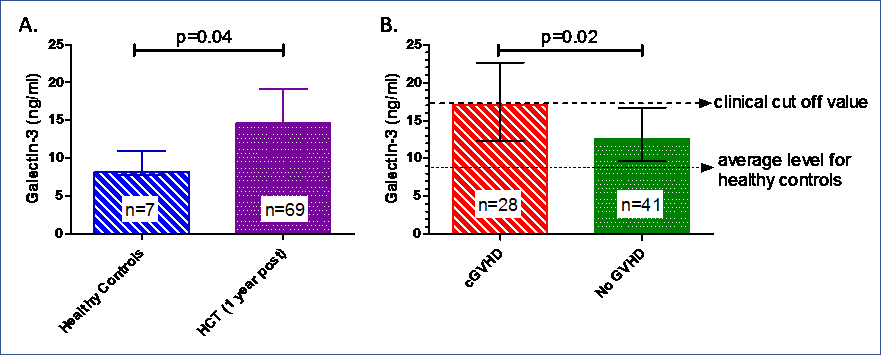Galectin-3 Levels Are Associated with the Incidence and Severity of Chronic GVHD One Year after Allogeneic Hematopoietic Cell Transplantation
1Center for Transplantation Sciences, Massachusetts General Hospital, Boston, MA, 2Blood and Marrow Transplant Program, Massachusetts General Hospital, Boston, MA, 3Hematologic Malignancies, Dana-Farber Cancer Institute, Boston, MA, 4Hematology/Oncology, Massachusetts General Hospital, Boston, MA, 5Plastic & Reconstructive Surgery and Transplant Surgery Divisions, University of Colorado, Denver, Aurora, CO
Meeting: 2019 American Transplant Congress
Abstract number: A129
Keywords: Bone marrow transplantation, Fibrosis, Graft-versus-host-disease, Inflammation
Session Information
Session Name: Poster Session A: Biomarkers, Immune Monitoring and Outcomes
Session Type: Poster Session
Date: Saturday, June 1, 2019
Session Time: 5:30pm-7:30pm
 Presentation Time: 5:30pm-7:30pm
Presentation Time: 5:30pm-7:30pm
Location: Hall C & D
*Purpose: Chronic graft-versus-host disease (cGVHD) is a frequent complication of allogeneic hematopoietic cell transplantation (HCT) and a leading cause of late morbidity and mortality. T- and B-cell activation, as well as inflammation and fibrosis are involved. Galectin-3 (Gal3) is known to modulate T-cell proliferation and B cell fate and has been shown to play a role in systemic inflammation and fibrosis. The purpose of this study is to evaluate whether Gal3 can be used as a predictive biomarker for cGVHD following HCT.
*Methods: We retrospectively studied 69 patients who underwent HCT between 2005 and 2014. The levels of Gal3 in 7 healthy controls vs. patients at 1 year post-HCT were determined. Subsequently, we analyzed Gal3 levels according to development of cGVHD, and correlated plasma levels with the severity and organ involvement of cGVHD.
*Results: Gal3 levels were significantly higher in HCT patients compared to healthy controls (median = 14.6, 8.21 ng/ml respectively, p=0.04) (Figure 1A). Among HCT patients, Gal3 levels were also significantly higher in patients who developed cGVHD (n= 28) compared with those with no cGVHD (n=41) 1 year post-HCT (median = 17, 12.55 ng/ml, p=0.02) (Figure 1B). Using the same cut-off value clinically used to predict adverse events in chronic heart failure patients (17.8 ng/ml), 48 HCT patients had Gal3 levels below (range: 5.5-17.6ng/mL; Gal3-Low) and 21 patients above this cut-off (range: 17.9-61.6 ng/mL; Gal3-High). Of the 48 Gal3-Low patients, 15 (31%) had cGVHD at 1 year post-HCT with 33% experiencing moderate-to-severe cGVHD over time. Of the 21 Gal3-High patients, 12 (57%) had cGVHD at 1 year with 47% experiencing moderate-to severe cGVHD. When analyzed by organ involvement, no clear differences were observed.
*Conclusions: These results demonstrate a significant difference in incidence and severity of cGVHD based on Gal3 levels at 1 year post-HCT, suggesting a potential role of Gal3 in the pathobiology of cGVHD. Further investigation will be required to determine whether it can serve as a predictive biomarker and potential therapeutic target for cGVHD in patients undergoing allogeneic HCT.
To cite this abstract in AMA style:
Navarro-Alvarez N, Andrews AR, DeFilipp Z, Chen YA, Ho VT, Ritz J, Spitzer TR, Huang CA. Galectin-3 Levels Are Associated with the Incidence and Severity of Chronic GVHD One Year after Allogeneic Hematopoietic Cell Transplantation [abstract]. Am J Transplant. 2019; 19 (suppl 3). https://atcmeetingabstracts.com/abstract/galectin-3-levels-are-associated-with-the-incidence-and-severity-of-chronic-gvhd-one-year-after-allogeneic-hematopoietic-cell-transplantation/. Accessed December 19, 2025.« Back to 2019 American Transplant Congress

